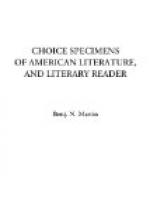* * * * *
From “The History of the Conquest of Peru.”
=_128._= RANSOM AND DOOM OF THE INCA.
These articles consisted of goblets, ewers, salvers, vases of every shape and size, ornaments and utensils for the temples and the royal palaces, tiles and plates for the decoration of the public edifices, curious imitations of different plants and animals. Among the plants, the most beautiful was the Indian corn, in which the golden ear was sheathed in its broad leaves of silver, from which hung a rich tassel of threads of the same precious metal. A fountain was also much admired, which sent up a sparkling jet of gold, while birds and animals of the same material played in the waters at its base. The delicacy of the workmanship of some of these, and the beauty and ingenuity of the design, attracted the admiration of better judges than the rude Conquerors of Peru.
Before breaking up these specimens of Indian art, it was determined to send a quantity, which should be deducted from the royal fifth, to the Emperor. It would serve as a sample of the ingenuity of the natives, and would show him the value of his conquests. A number of the most beautiful articles was selected, to the amount of a hundred thousand ducats, and Hernando Pizarro was appointed to be the bearer of them to Spain.
The doom of the Inca was proclaimed by sound of trumpet in the great square of Caxamalca; and, two hours after sunset, the Spanish soldiery assembled by torch-light in the plaza to witness the execution of the sentence. It was on the twenty-ninth of August, 1533. Atahuallpa was led out chained hand and foot,—for he had been kept in irons ever since the great excitement had prevailed in the army respecting an assault. Father Vicente de Valverde was at his side, striving to administer consolation, and, if possible, to persuade him at this last hour to abjure his superstition and embrace the religion of his Conquerors. He was willing to save the soul of his victim from the terrible expiation in the next world, to which he had so cheerfully consigned his mortal part in this.




